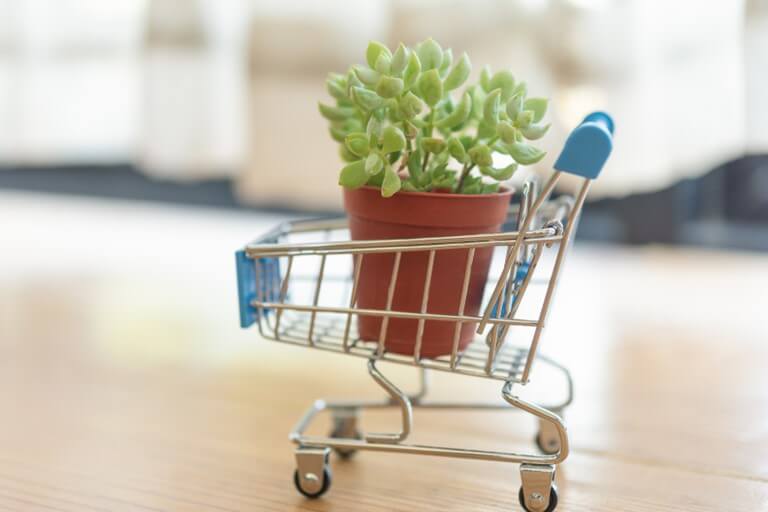Mini-Plants for Gardeners with Small Spaces

There are a number of mini-plants that are ideal for the homes of gardeners who have little space. These types of plants are trending on social networks, although, there’s far more than fashion behind their popularity.
We’ve written this article to help you learn more about these small species. As such, we’ll discuss the varieties, their care, and their benefits. If you’re interested to discover more about this mini-ecosystem, keep reading!
What are mini-plants?
The concept of mini-plants generates curiosity. Well, we’re referring to the earliest stages of development in a species of flora. Mini-plants are in the initial phase of life, after germination. During this period, they’re small, fragile, and charming.

Benefits of having mini-plants
Having any plant, regardless of its size, brings outstanding benefits. As research into horticultural therapy demonstrates, caring for plants decreases levels of depression. Furthermore, mini-plants represent the following advantages:
- They’re small, adorable, and beautiful: you can watch their growth and development.
- They don’t take up a lot of space: if you live in a small apartment, you won’t have a problem finding a little corner for them.
- Some are functional: they purify the air, retain moisture, and keep mosquitoes away during the summer.
- Their presence reduces heat: generating a feeling of freshness, the more plants you have, the greater the benefit.
What mini-plants could I have?
Being so young and sensitive, it’s worth starting out with some resistant mini-plants. Now, you can choose among the ficus and monsteras varieties or others with a more decorative tint such as the maranta. Next, we’ll delve deeper into all the possibilities and potentials.
Begonia maculata
The begonia maculata is a beautiful plant and its mini version is more than charming. It’s native to the tropical areas of Mexico and it has large, cascading green leaves with white spots.
It’ll enjoy a spot with indirect sunlight alongside moderate irrigation. Avoid watering this plant in excess, otherwise it may harm and rot the roots.
Senecio rowleyanus
Senecio rowleyanus, also known as string of beads, or rosary, is a popular houseplant. It’s a hanging succulent with long, thin stems, surrounded by round, fleshy leaves. Take care of it with moderate watering, since it’s resistant to drought, and overwatering will damage it.
Mini ficus
The mini ficus has a great advantage because it purifies the air and absorbs toxic air-borne substances. In addition, it neutralizes formaldehyde, trichloroethylene, and benzene.
It’s also known as the ficus bonsai and it requires continuous watering, plenty of sunshine, and a light and airy space.
General care

Mini-plants, like any living species, require some care. This varies greatly depending on the species you’ve chosen, but there are some general rules that you should know. Most of them enjoy indirect sunlight. Direct sunlight can spoil the leaves, turning them yellow or even burning them.
It’s best to water them according to the exact needs of each species and always use filtered water. Moreover, you should irrigate by immersion. This means placing the plant in a container of water so that the plant can take in the liquid it needs.
Lastly, you can add fertilizer to the water every month to help nourish the substrate and guarantee the well-being of all your mini-plants.
Where should I put my mini-plants?
As we mentioned before, your mini-plants shouldn’t be placed in direct sunlight. When it comes to aesthetics, they’ll look beautiful in the hallway, in your study, or workplace. If you opt for a hanging species, a corner spot or high shelf will show off its beauty.
If you’ve chosen aromatic mini-plants, the kitchen is a good place to have them. Mark the pots with the name of each particular species and simply enjoy them.
There are a number of mini-plants that are ideal for the homes of gardeners who have little space. These types of plants are trending on social networks, although, there’s far more than fashion behind their popularity.
We’ve written this article to help you learn more about these small species. As such, we’ll discuss the varieties, their care, and their benefits. If you’re interested to discover more about this mini-ecosystem, keep reading!
What are mini-plants?
The concept of mini-plants generates curiosity. Well, we’re referring to the earliest stages of development in a species of flora. Mini-plants are in the initial phase of life, after germination. During this period, they’re small, fragile, and charming.

Benefits of having mini-plants
Having any plant, regardless of its size, brings outstanding benefits. As research into horticultural therapy demonstrates, caring for plants decreases levels of depression. Furthermore, mini-plants represent the following advantages:
- They’re small, adorable, and beautiful: you can watch their growth and development.
- They don’t take up a lot of space: if you live in a small apartment, you won’t have a problem finding a little corner for them.
- Some are functional: they purify the air, retain moisture, and keep mosquitoes away during the summer.
- Their presence reduces heat: generating a feeling of freshness, the more plants you have, the greater the benefit.
What mini-plants could I have?
Being so young and sensitive, it’s worth starting out with some resistant mini-plants. Now, you can choose among the ficus and monsteras varieties or others with a more decorative tint such as the maranta. Next, we’ll delve deeper into all the possibilities and potentials.
Begonia maculata
The begonia maculata is a beautiful plant and its mini version is more than charming. It’s native to the tropical areas of Mexico and it has large, cascading green leaves with white spots.
It’ll enjoy a spot with indirect sunlight alongside moderate irrigation. Avoid watering this plant in excess, otherwise it may harm and rot the roots.
Senecio rowleyanus
Senecio rowleyanus, also known as string of beads, or rosary, is a popular houseplant. It’s a hanging succulent with long, thin stems, surrounded by round, fleshy leaves. Take care of it with moderate watering, since it’s resistant to drought, and overwatering will damage it.
Mini ficus
The mini ficus has a great advantage because it purifies the air and absorbs toxic air-borne substances. In addition, it neutralizes formaldehyde, trichloroethylene, and benzene.
It’s also known as the ficus bonsai and it requires continuous watering, plenty of sunshine, and a light and airy space.
General care

Mini-plants, like any living species, require some care. This varies greatly depending on the species you’ve chosen, but there are some general rules that you should know. Most of them enjoy indirect sunlight. Direct sunlight can spoil the leaves, turning them yellow or even burning them.
It’s best to water them according to the exact needs of each species and always use filtered water. Moreover, you should irrigate by immersion. This means placing the plant in a container of water so that the plant can take in the liquid it needs.
Lastly, you can add fertilizer to the water every month to help nourish the substrate and guarantee the well-being of all your mini-plants.
Where should I put my mini-plants?
As we mentioned before, your mini-plants shouldn’t be placed in direct sunlight. When it comes to aesthetics, they’ll look beautiful in the hallway, in your study, or workplace. If you opt for a hanging species, a corner spot or high shelf will show off its beauty.
If you’ve chosen aromatic mini-plants, the kitchen is a good place to have them. Mark the pots with the name of each particular species and simply enjoy them.







